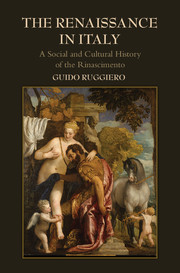Book contents
- Frontmatter
- Dedication
- Contents
- List of Illustrations
- Acknowledgments
- Maps
- Introduction: The End of the World and Its Rebirth (Rinascita) as the Rinascimento
- 1 Legitimacy: A Crisis and a Promise (c. 1250–c. 1340)
- 2 Civiltà: Living and Thinking the City (c. 1300–c. 1375)
- 3 Plague: Death, Disaster, and the Rinascita of Civiltà (c. 1325–c. 1425)
- 4 Violence: Social Conflict and the Italian Hundred Years’ War (c. 1350–1454)
- 5 Imagination: The Shared Primary Culture of the Early Rinascimento (c. 1350–c. 1475)
- 6 Courts: Princes, Aristocrats, and Quiet Glory (c. 1425–c. 1500)
- 7 Self: The Individual as a Work of Art (c. 1425–c. 1525)
- 8 Discovery: Finding the Old in the New (c. 1450–c. 1560)
- 9 Re-Dreams: Virtù, Saving the Rinascimento, and the Satyr in the Garden (c. 1500–c. 1560)
- 10 Reform: Spiritual Enthusiasms, Discipline, and a Church Militant (c. 1500–c. 1575)
- 11 Retreat: The Great Social Divide and the End of the Rinascimento (c. 1525–c. 1575)
- Epilogue: The Diaspora of the Rinascimento
- Bibliography: A Short List of Works Used
- Index
9 - Re-Dreams: Virtù, Saving the Rinascimento, and the Satyr in the Garden (c. 1500–c. 1560)
Published online by Cambridge University Press: 05 December 2014
- Frontmatter
- Dedication
- Contents
- List of Illustrations
- Acknowledgments
- Maps
- Introduction: The End of the World and Its Rebirth (Rinascita) as the Rinascimento
- 1 Legitimacy: A Crisis and a Promise (c. 1250–c. 1340)
- 2 Civiltà: Living and Thinking the City (c. 1300–c. 1375)
- 3 Plague: Death, Disaster, and the Rinascita of Civiltà (c. 1325–c. 1425)
- 4 Violence: Social Conflict and the Italian Hundred Years’ War (c. 1350–1454)
- 5 Imagination: The Shared Primary Culture of the Early Rinascimento (c. 1350–c. 1475)
- 6 Courts: Princes, Aristocrats, and Quiet Glory (c. 1425–c. 1500)
- 7 Self: The Individual as a Work of Art (c. 1425–c. 1525)
- 8 Discovery: Finding the Old in the New (c. 1450–c. 1560)
- 9 Re-Dreams: Virtù, Saving the Rinascimento, and the Satyr in the Garden (c. 1500–c. 1560)
- 10 Reform: Spiritual Enthusiasms, Discipline, and a Church Militant (c. 1500–c. 1575)
- 11 Retreat: The Great Social Divide and the End of the Rinascimento (c. 1525–c. 1575)
- Epilogue: The Diaspora of the Rinascimento
- Bibliography: A Short List of Works Used
- Index
Summary
Re-Dreams of Virtù: Machiavelli and Other Secular Prophets
Niccolò Machiavelli (1469–1527) would become one of the most prominent secular prophets who presented a vision of social and cultural reform that might save the Rinascimento in its time of crisis, even as he was often portrayed as one of the most dangerous satyrs in its garden – if not the Serpent himself. But there was no lack of other prophets with competing visions for saving Italy. Along with Old Nick, three other important and controversial figures seem particularly significant in the rethinking of the civiltà of the day that was a much more general phenomenon in the early sixteenth century: Baldassare Castiglione (1478–1529), Ludovico Ariosto (1474–1533), and Pietro Aretino (1492–1556). Each in his own way wrestled with the underlying problem of the new that threatened Italy and its urban society and culture. Moreover, if at first sight their ideas seem profoundly different, at least for Machiavelli and Castiglione, their underlying answer to the problems of Italy was based upon a long established discourse that ran deeply in the shared primary culture of the Rinascimento.
Both called for a return to that virtù that had made Italy great, and both shared the vision that it was the lack of virtù that had opened the doors of Italy to conquerors from over the Alps: for it was a lack of virtù that had led to the corrupt and ineffective governments of the recent past, and it was a lack of virtù that had made the people of Italy “soft and effeminate.” Thus in returning to virtù, and to the way Machiavelli and Castiglione used the term to think about the troubled nature of their day, rather than merely examining the vision of famous writers on virtù, we are once again tracing the parameters of a particularly significant discourse of the primary culture of the day – a shared discourse that drew much of its strength from its long tradition of defining moral and social superiority with a classical pedigree.
- Type
- Chapter
- Information
- The Renaissance in ItalyA Social and Cultural History of the Rinascimento, pp. 438 - 488Publisher: Cambridge University PressPrint publication year: 2014



